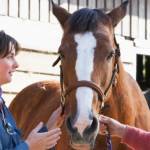Questions about Insulin Resistance

Over the past several years, equine nutritionists and veterinarians have begun to understand better the puzzling condition known as insulin resistance. As more is learned about this syndrome, quick diagnosis and effective management techniques have developed. Because of the complexity of insulin resistance, the nutritionists at Kentucky Equine Research (KER) have formulated answers to some frequently asked questions. As you will learn, insulin resistance is a syndrome that can be managed with the help of your veterinarian and an equine nutritionist.
What is insulin resistance?
Simply put, insulin resistance is the failure of body tissues to respond as expected to the hormone insulin.
Here’s a little more background. Glucose is the primary energy source by which most cells in the body are powered. As blood levels of glucose rise, such as after a meal, the pancreas releases insulin. The mechanisms that allow different cells to absorb glucose from the bloodstream are complicated and highly individual. Certain cells, like those in muscle and fat, are incredibly dependent on insulin to usher in glucose to fuel body processes.
Insulin resistance occurs when the cells become less sensitive to insulin, thereby limiting the uptake of glucose. When this occurs, more and more insulin is required to move glucose out of the bloodstream and into cells. When insulin resistance is severe enough, glucose accumulates in the blood, thus limiting the availability of energy to cells.
What are the signs of insulin resistance?
If a horse shows any of the following signs, he might be at risk for developing or having insulin resistance:
- Laminitis of uncertain origin
- Rapid and/or continuous weight gain, especially if placed on diets that could not sustain an average horse
- Unusual fat deposits on the crest, shoulders, withers, croup, and base of tail, even if the horse is trim in other areas
- Abnormally rapid weight gain following a reduction or cessation of an exercise program
How is a horse definitively diagnosed with insulin resistance?
A veterinarian can draw a blood sample and measure the amount of insulin present. If the results of this initial screening test indicate hyperinsulinemia, a veterinarian may choose to perform a battery of more specific tests involving oral and intravenous glucose administration, and measurement of responses over several hours.
What can be done for a horse that is diagnosed with insulin resistance?
Controlling the effects of insulin resistance is possible in many cases. If laminitis is not an issue, daily exercise is a good starting point. Because many affected horses are overweight and out of shape, take the time to slowly build the horse’s condition. The goal is for the horse to be exercised 30 minutes each day, primarily at the trot and canter. Exercise does not have to come in the form of riding; longeing and ponying the horse are alternatives that offer the same benefits. The exercise will invariably help with weight loss. At the same time a schedule of suitable exercise is created, a review of the diet should also be performed.
What is an appropriate diet for a horse with insulin resistance?
Once a diagnosis has been made, a horse’s diet might have to be overhauled to greatly reduce or eliminate nonstructural carbohydrates in the diet. Grains and high-sugar feeds should be cut completely from the diets of obese horses, as should hays that are high in sugars. Hay can be tested for nonstructural carbohydrate content to determine if it is appropriate for horses with insulin resistance. It is impossible to say which hay varieties are better for these horses, as sugar content depends largely on the environment in which the hay was grown and not necessarily on the forage’s genetic potential. If the sugar content of hay is unknown, the hay can be soaked in hot water for 30 minutes or cold water for 60 minutes to make it more suitable for insulin-resistant horses. Soaking removes most of the sugar from the plant.
A base diet of low-sugar, good-quality hay is usually a safe place to begin. If additional fiber or a carrier for supplements is needed, beet pulp without molasses works well. Be especially careful when purchasing beet pulp, as some brands do not explicitly state on their packaging if they contain molasses. If unsure, it’s best to contact the manufacturer for details. Concentrates are sometimes needed to maintain body condition once an exercise program has been established. If this is the case, a feed with a low glycemic index is necessary. These products are generally called “low-starch” feeds in the marketplace. Some feeds that are advertised as having minimal starch could contain much more starch than others making the same claim. Therefore, it’s a good idea to consult with your feed manufacturer for information on the best feed for your horse.
Whether or not horses diagnosed with insulin resistance should have access to pasture is probably a decision best made by a team consisting of a veterinarian, an equine nutritionist, and the horse owner. Some horses with a history of laminitis are restricted from pasture entirely, even in winter. Some reports suggest that dead or dormant grasses, such as those found in pastures during the winter, may contain sufficient nonstructural carbohydrates to be problematic. If the professionals give the green light for pasture, you still might want to consider a grazing muzzle so that intake is curbed somewhat.
Caught in its early stages, insulin resistance can be managed quite easily by daily exercise and a carefully formulated diet. For those horses with advanced symptoms of the syndrome including laminitis, the appropriate course of treatment might be more convoluted. With the assistance of a veterinarian and an equine nutritionist, the likelihood of horses returning to a useful life is possible.
Researchers continue to unravel the mysteries of insulin resistance. Though the causes of the syndrome remain elusive, proper management seems to keep horses free of the long-term effects of insulin resistance.








